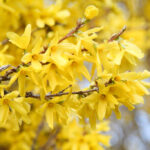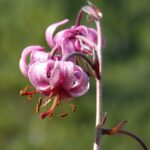Pruning and cutting back of the bunch-flowering tulip

After the vibrant, multi-headed blooms of Tulipa praestans have passed their peak and the petals begin to fall, a simple but crucial task known as deadheading should be performed. Deadheading is the process of removing the spent flower heads from the plant. The primary purpose of this action is not merely cosmetic; it is a vital step in redirecting the plant’s energy towards the most important goal: strengthening the bulb for the following year’s display. If the faded flowers are left on the stem, the plant’s natural instinct is to begin producing seeds, a process that consumes a significant amount of its precious energy reserves.
By removing the developing seed pod, you effectively halt this energy-draining process. All the energy that would have gone into seed production is now channelled downwards, back into the bulb. This energy is stored in the form of carbohydrates and is used to fuel the bulb’s survival through its summer dormancy and to initiate the formation of the flower embryos for the next spring. Consistent deadheading is one of the most significant factors that contributes to the successful perennialization of tulips, ensuring they return with vigour year after year.
The process of deadheading is simple and can be done in one of two ways. You can either use a clean, sharp pair of secateurs or scissors to snip off the flower head at the top of the stem, just below the base of the flower. Alternatively, you can simply snap the head off with your fingers. It is important to remove only the flower head and the small section of stem immediately below it. The main flower stalk and all the leaves must be left intact and undisturbed.
This task should be carried out as soon as the flowers look tatty and have lost their ornamental value. There is no benefit to leaving the withered blooms on the plant. By deadheading promptly, you maximize the amount of time the plant has to focus its energy on bulb replenishment. This simple act of garden maintenance, which takes only a few moments, pays significant dividends in the long-term health and performance of your bunch-flowering tulips.
Why you must not cut the foliage
The period after flowering is the most critical time for the tulip bulb’s life cycle, and the single biggest mistake a gardener can make during this phase is to prematurely cut back the foliage. While the green leaves may start to look untidy and flop over, they are now functioning as the plant’s engine room. They are actively photosynthesizing, capturing sunlight and converting it into the essential food reserves that are being transported down to the bulb. Cutting the leaves off while they are still green effectively starves the bulb and severely compromises its ability to produce a flower the following year.
More articles on this topic
It is absolutely essential to allow the foliage to remain on the plant until it has completed its work and has withered and turned completely yellow or brown on its own. This natural process of senescence is the visual confirmation that the transfer of energy to the bulb is complete. At this point, the leaves will have a dry, papery texture and will often pull away from the ground with a gentle tug. This process typically takes around six weeks after the flowering period has ended.
During this foliage maturation period, it is important to continue to care for the plant. If the weather is dry, provide occasional watering to keep the soil lightly moist, as the roots are still active. The temptation to braid, tie up, or bundle the leaves to make them look neater must also be resisted. While well-intentioned, these actions fold and crease the leaves, reducing the surface area exposed to the sun and restricting the flow of nutrients within the plant’s vascular system, thereby hindering the vital process of photosynthesis.
The aesthetic issue of the declining foliage is best managed through clever companion planting. As discussed previously, positioning your tulips among perennials like hostas, geraniums, or daylilies whose foliage emerges later in the spring is an excellent strategy. As these companion plants grow, their leaves will naturally unfurl and expand, effectively camouflaging the yellowing tulip leaves and ensuring the garden bed remains attractive throughout the transition.
Cutting flowers for indoor arrangements
The multi-flowered stems of Tulipa praestans make them a charming and delightful cut flower for bringing a splash of spring colour indoors. However, when cutting the flowers for arrangements, it is important to do so in a way that minimizes the negative impact on the bulb’s health. The key principle to remember is that every leaf you remove detracts from the bulb’s ability to recharge itself for the following season. Therefore, the goal is to cut the flower stem while leaving as much of the foliage on the plant as possible.
More articles on this topic
The best time to cut tulips for the vase is in the cool of the morning when the flowers are fully hydrated. Select stems where the buds are showing full colour but have not yet fully opened. This will ensure the longest possible vase life. Using a sharp, clean knife or secateurs, cut the stem at an angle. Try to leave at least two of the largest leaves remaining on the plant at its base. These lower leaves are the most important for photosynthesis, and leaving them intact gives the bulb a fighting chance to recover and bloom again next year.
Once cut, immediately place the stems into a clean vase filled with cool water. It can be beneficial to re-cut the stems underwater to prevent air bubbles from entering the vascular system, which can block water uptake. Adding a floral preservative to the water can also help to extend the life of the blooms and keep the water clean. Keep the vase in a cool location, away from direct sunlight and sources of heat, and change the water every day or two to keep the flowers fresh.
While cutting the flowers is a wonderful way to enjoy them, it is important to acknowledge that it will inevitably have some impact on the bulb’s vigour. For this reason, if your primary goal is the long-term perennialization and naturalization of a large outdoor display, it is best to limit the number of flowers you cut. Consider having a dedicated cutting patch, or resolve to sacrifice the blooms on a few plants for indoor enjoyment while leaving the majority in the garden to complete their natural life cycle undisturbed.

















